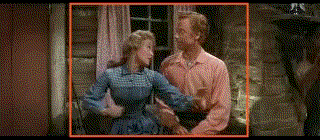Hi,
I'm new to the forum. How can I crop video's, without the black bars ?? I'm trying to convert 4:3 to widscreen, cause now I am using a widescreen monitor. This is a tricky question, I have tried many way's.
What I am trying to do is, take a movie let's say 640x480 and convert it to widescreen with no side black bars. I get so confused, Lol,. I use Virtualdub to crop the videos.
How much do I need to crop top/bottom, for the video to become widescreen ??
Also, is there a ratio for converting resolutions ? Let's say, I want to take a 640x480 video and resize it to 960x540 ?? or vice versa, without distortion. Quality is not a factor. Is there any program, I can just punch in the resolutions, and the program recalculates to proper sizing. Such as I punch in 960x540 then 720x480, and it give me the proper downscale size ??
Thanks for any help.
+ Reply to Thread
Results 1 to 18 of 18
-
-
You should crop it to 640x360 ( 640/360 = 1.777 = 16:9). So crop 60 pixels at bottom and 60 pixels at top. Then upresize to 960x540.
What is you goal ? make a dvd? -
Hi,
Thanks for reply. I've never liked watching movies with black bars. I rencently bought a widescreen monitor and trying to convert my video's to widescreen.
I use Virtualdub to crop the videos. When I crop a 640x480 vid, top/bottom 60, what happens when I watch the video is, it converts it to widescreen, but I get a black bar on the left side of the monitor ?? As if the widescreen movie shifted to towards the right ?? Confusing. Maybe it's my monitor resolution, I have it set to 1360x768, by manufacturer's instructions. -
assuming your creating DVD's from these videos, you have 640*360 after the crop, but dvd's are 720*480
your conversion is likely padding the left side with 80 pixels, you need to resize before the frame is encoded
did you use vdub to frame serve to your encoder, have it resize to 720*480, and encode with a 16:9 aspect DAR
you might better off using fitcd & avisynth what are you using for encoding and authoring
ME i would rather leave the 640*480 video alone, watch it full size in the center of the screen, instead of losing picture from top and bottom to make it wide screen
heres an avisynth script fora source video of 640*360 into dvd res 720*480 will will display as anamorphic 16:9 WS
# -= AviSynth v2.5.8.0 script by FitCD v1.2.8 =-
DirectShowSource("C:\my documents\Movie.avi")
LanczosResize(704,480,0,0,640,360)
AddBorders(8,0,8,0)
#Trim(0,-1).FadeOut(150)
ConvertToYUY2() # For VirtualDub or CCE
this one should crop your 640*480 to 640*360 then resize to 720*480 DVD anamorphic 16;9 WS
# -= AviSynth v2.5.8.0 script by FitCD v1.2.8 =-
DirectShowSource("C:\my documents\Movie.avi")
LanczosResize(704,480,0,60,640,360)
AddBorders(8,0,8,0)
#Trim(0,-1).FadeOut(150)
ConvertToYUY2() # For VirtualDub or CCE
if you want 960*540, then you will be playing it from your PC or avi -DviX file on disc , and not from DVD standard
and will need different settings/scripts -
There's the best plan, right there. Leave it alone.ME i would rather leave the 640*480 video alone, watch it full size in the center of the screen, instead of losing picture from top and bottom to make it wide screen
-
Maybe there is another approach (I must confess, I never tried it). This is an avisynth filter called SimpleResize (by trbarry). It has a function called WarpedResize. It will try to convert 4:3 to 16:9 (or vice versa) with the resizing. Here is a part of the readme for SimpleResize:
Code:WarpedResize WarpedResize is also included in the SimpleResize.dll. WarpedResize will do a non-linear stretch/squeeze in both the horizontal and vertical dimensions. This can be useful when you want to change the aspect ratio of a video clip and have it mostly distorted at the top, bottom, and side edges. This is mostly experimental but I added it because it required few code changes and almost Zero performance penalty. Use as: LoadPlugin("F:\SimpleResize\SimpleResize.dll") Avisource("D:\wherever\myfile.avi") WarpedResize(width,height,hWarp,vWarp) where hWarp & vWarp are the horizontal and vertical warp factors. These are real number, usually between .8 and 1.3 that determine how non-linear you really want the output to be. Values above 1.0 cause the output image to be stretched more in the middle and squeezed at the edges. Values below 1.0 will do the reverse. Specifying 1.0 for either of them will do a linear resize in that dimension, just as you would get using SimpleResize. Values far from 1.0 will give some very strange results. See the "Notes to Mathematicians" below. One reason to use WarpedResize would be when you have a clip with a 16:9 aspect ratio and want to resize it for a 4:3 aspect ratio display without either clipping off valuable info or having to display black bars. (or vice versa) An example image of using WarpedResize for this can be found (for now) at www.trbarry.com/WarpTest.jpg. This image was from a short HDTV digital capture that was at a 1280x720 resolution, a 16:9 aspect ratio. It was downsized and warped to a 640x480 4:3 aspect ratio using the following script command: WarpedResize(640,480,1.15,0.95)) Also, for an example of a 4:3 capture warped to fit on a 16:9 screen see www.trbarry.com/WarpTest2.jpg Current limitations, for SimpleResize/WarpedResize: 1) Only YUY2 color mode is currently supported. Add a ConvertToYuY2 command first if needed. 2) The target width NO LONGER must be a multiple of 4 pixels. 3) It will run faster on SSE2 machines if the target width is a multiple of 8 pixels and if the data starts on an 8 pixel boundary. I don't know if prior Clip() commands affect this or not. 4) If anyone knows how to make a DirectShow filter out of this I'd sure like to have one. ;-) Notes to Mathematicians: (and questions) Imagine the screen was dimensions that went from -1.0 to 1.0. We'll only consider the horizontal dimension for the moment and only the right hand half of the screen. Assume we want to calculate the value of an output pixel at location x, where 0 <= x <=1. The output value will be the source value from the input screen with the same dimensions, at location s. Right now I'm just calculating s = (1-w) * x^3 + w * x, where w is the warp factor mentioned above (Later note: w = 2 - warp factor, for compat with first release). This gets the job done and produces smooth numbers from 0 to one, without too much distortion as long as w is close to 1.0. The same formula is reflected for the left half of the screen. The warp equations are designed to: * Always be rising but yield results from 0 to 1 * Have a first derivative that doesn't go to 0 or infinity, at least close to the center of the screen * Have a curvature (absolute val of 2nd derivative) that is small in the center and smoothly rises towards the edges. We would like the curvature to be everywhere = 0 when the warp factor = 1 Now, as near as I can tell the curvature is more or less just the absolute value of the second derivative. So if we wanted the curvature to be small when x = 0 and to grow toward the edges, what could be a useful warp function? The above function already represents a change since V 0.1 but I'm still not so sure it's the best. It is easy to drop in another warp function. And there is no performance penalty either way because it's just calculated and tabled at startup. After that it runs at the same speed as SimpleResize. Anyone have any ideas? (Anybody care about this part?) -
interesting approach
stretch the edges out, and keep the center the correct perspective
or conversely squeeze the edges when going from 16:9 to 4:3
I like leaving it alone and watching it.. as the best idea
but at least the OP has some choices
and LIFE is about choices -
I had a TV that could do that. That mode was designed for the idiots that like to watch 4:3 programming fill the screen of a 16:9 TV set without making everyone look short and fat the way a normal stretch mode does. The center of the screen was almost normal and the outsides were hideously stretched. Watching channels with a ticker at the bottom, like CNN or CNBC, clearly showed how stupid an idea it was. I'm not knocking Abond for bringing it up, but only anyone that wants to watch anything in something other than the intended original aspect ratio.
-
One other issue: widescreen computer monitors are usually 16:10 not 16:9. Although 1360x768 is 16:9.
-
True 16:9 on a 16:10 monitor results in minor letterbox for square pixel.
For a 1680x1050 computer LCD, 16:9 fills 1680x945 leaving 52 pixel wide letterbox at the top and bottom. If the monitor overscanned 5% like an LCD-TV, the letterbox wouldn't be visible.Recommends: Kiva.org - Loans that change lives.
http://www.kiva.org/about -
Hi,Originally Posted by manono
I have no problems watching tv in standard format and with dvd I have a choice between fullscreen/widescreen. I can also use my remote control to change the formats, etc...
When video editing, I crop movies to remove logo's & subtitles, and figured if I had to crop, I might as well, crop to widescreen. My computer monitor is widescreen.
If anyone is an idiot, it's the manufacturer's, that can't decide, what standard format should be used. If one standard was universal, then everyone would accept the standard, but we have a choice, and I choose widescreen over fullscreen, no reason to refer to people as idiots, because they make a choice.
Even HD DVD & Blu ray, can't decide on a standard format. Does that make someone that purchases one or the other an idiot, because they have a preference.
Peace -
There is consensus that all HDTV will be 16:9. That doesn't mean that you have to hack up legacy 4:3 masters. It means you display 4:3 with side bars. Kudos to Universal HD for airing Northern Exposure 35mm transfers in HD as 4:3. This is what your movie theater does, except they close the curtains a bit.Originally Posted by Illusionist
 Recommends: Kiva.org - Loans that change lives.
Recommends: Kiva.org - Loans that change lives.
http://www.kiva.org/about -
I think Manono was refering to a mode called 'panorama on my TV', its dynamic mode not static, and as something moves across the screen to / from center and the edges it stretches or squishes, its terrible, and something i NEVER use, and IMO should never have been thought of and installed/programmed into the TV, its pure UGLY
its like trying to watch TV in a fun house mirror -
TBS-HD sometimes uses something similar for 4:3 versions of movies.
This is on the TBS SD channel. Actually the SD channel is proper aspect ratio all the way across. I just H scaled this from the picture below.

This is how they distort it to 16:9. It looks worse in movement as people change thickness as they walk across the screen.

The 4:3 version is usually a pan-scan crop from the original 2.35:1 aspect movie print. Stretching the 4:3 crop out to 16:9 produces strange results.
Here is a great example of pan-scan that I found here http://content.answers.com/main/content/wp/en/7/74/PanScan7BridesPan.gif
 Recommends: Kiva.org - Loans that change lives.
Recommends: Kiva.org - Loans that change lives.
http://www.kiva.org/about -
pan scan crop takes work, the print has to be prepared before it is aired
usually by a flim house connected with the movie studio, its the proper way to treat a movie, for presentation on 4:3
that is all going away, as WS becomes the norm
but then there is TBS with a large catalog of Pan & scan films now trying to show them on wide screen broadcast instead of negoating with the studios for the original format films -
Oops I said TBS when I meant TNT but they are the same company. Pan and scan is a non letterbox solution for SD broadcast but stretching that out to 16:9 is silly. HBO and others use a 16:9 pan and scan technique to avoid letterbox on 2.35:1 or wider films.
I prefer letterbox to pan and scan but that is me.Recommends: Kiva.org - Loans that change lives.
http://www.kiva.org/about -
I prefer letter box also
I my last commet was about what TNT/TBS is doing, and it is awful
any way its up to the OP what he does with his material now
Similar Threads
-
Video resolution (image size) calculator
By headless chicken in forum MacReplies: 10Last Post: 15th Jan 2011, 18:17 -
Correct size Resolution for AVI
By Sliztzan in forum EditingReplies: 45Last Post: 25th May 2010, 11:01 -
Youtube Default Screen size / resolution
By Juc1 in forum Video Streaming DownloadingReplies: 4Last Post: 7th Apr 2010, 07:48 -
How much does resolution affect file size?
By milkydoo in forum Video ConversionReplies: 3Last Post: 16th Sep 2009, 18:29 -
Is there a maximum resolution or size for jpgs imported into Vegas 7?
By nzo in forum Newbie / General discussionsReplies: 2Last Post: 8th Oct 2007, 21:18




 Quote
Quote